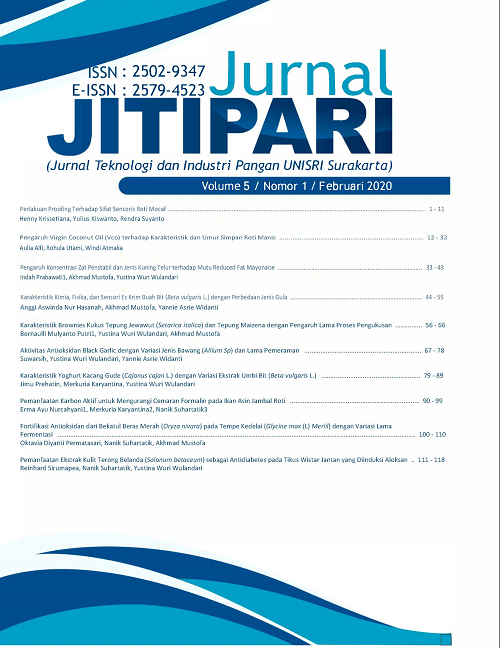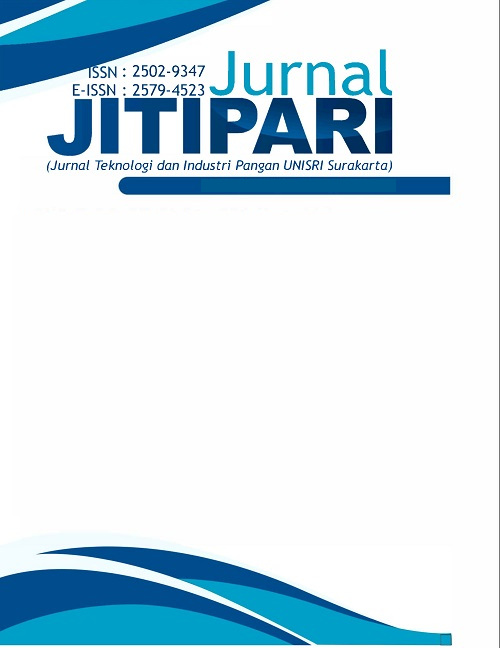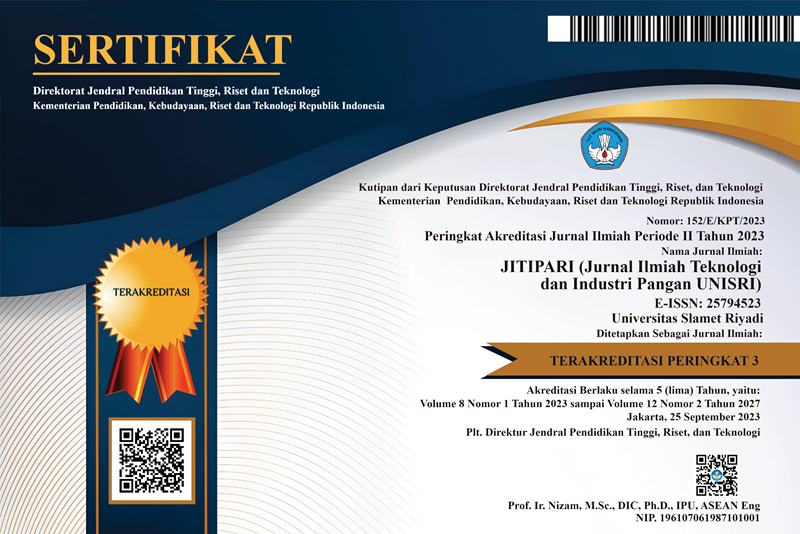KARAKTERISTIK KIMIA, FISIKA, DAN SENSORI ES KRIM BUAH BIT (Beta vulgaris L.) DENGAN PERBEDAAN JENIS GULA
DOI:
https://doi.org/10.33061/jitipari.v5i1.3641Abstract
Es krim adalah produk pangan beku yang dibuat dengan kombinasi proses pembekuan dan agitasi dengan bahan-bahan yang terdiri dari susu, pemanis, pengemulsi, penstabil dan flavor. Penambahan buah bit dan berbagai jenis gula dapat meningkatkan nilai gizi es krim. Penelitian ini bertujuan untuk mengetahui aktivitas antioksidan yang tertinggi pada produk dan mengetahui karakteristik kimia, fisika, dan sensori es krim buah bit. Penelitian ini menggunakan metode Rancangan Acak Lengkap (RAL) dengan menggunakan dua faktor. Faktor pertama adalah bubur buah bit (20%, 30%, dan 40%) dan faktor kedua yaitu jenis gula (gula pasir, gula stevia, dan madu). Hasil penelitian menunjukkan bahwa perlakuan es krim yang terbaik diperoleh berdasarkan aktivitas antioksidan tertinggi es krim yaitu pada perlakuan bubur buah bit 40% dan jenis gula berupa madu. Pada perlakuan tersebut memiliki karakteristik: aktivitas antioksidan 32,474% kadar protein 2,139%; kadar lemak 0,145%; kadar gula total 7,064%; overrun 14,172%; kecepatan meleleh 36,660 menit; warna 2,958 (ungu); rasa manis 2,500 (sedikit manis); tekstur lembut 3,216 (lembut); flavor buah bit 3,342 (semakin nyata); dan kesukaan keseluruhan 2,705 (sedikit suka).
Â
Kata kunci: Es krim, buah bit, jenis gula
Â
ABSTRACT
Ice cream is a product of frozen food that made with a combination of the process of freezing and agitation with ingredients consisting of milk, sweetener, emulsion, stabilizer, and flavor. The addition of beet fruit and the kind of sugar can improve the nutrition value of ice cream. The purpose of this research were to determine the highest antioxidant activity in a product and to determine the characteristic of physicochemical and sensoric characteristic of beet ice cream. This research used the method of Completely Randomized Design (CRD) with two factors. The first factor was porridge of beet fruit (20%, 30%, and 40%) and the second factor was the type of sugar (cane, stevia, and honey). The result of this research indicates that the best treatment of ice cream based on the highest antioxidant activity was on the treatment of porridge beet fruit 40% and the type of sugar is honey. These treatment has a characteristic antioxidant activity 32,474%; protein 2,139%; fat 0,145%; the total of sugar 7,064%; overrun 14,172%; the velocity of melting 36,660 minutes; color 2,958 (purple); sweet taste 2,500 (a little sweet); soft texture 3,216 (soft), flavour of beet fruit 3,342 (more real); and the total of predilection 2,705(a little like).
Keywords: Ice cream, beet fruit, type of sugar
References
Bodyfelt F., Tobias., & Trout G. (1998). The sensory evaluation of diary product. New York: Van Nostrand Reinhold.
Bogdanov, S., Jurendic, T., Sieber, R., & Gallman, P. (2009). Honey for nutrition and health. American Journal of the College of Nutrition, 27(6), 677-689.
Budiyono, H. (2009). Analisis daya simpan produk susu pasteurisasi berdasarkan kualitas bahan baku mutu susu. Jurnal Paradigma, 10(2), 198-211.
Darma, G. S., Diana P., & Endang, N. (2013). Pembuatan es krim jagung manis kajian zatpenstabil, konsentrasi non dairy cream serta aspek kelayakan finansial. Jurnal Teknologi Industri Pertanian, 1(1), 45-55.
Darwin, P. (2013). Menikmati gula tanpa rasa takut. Yogyakarta: Sinar Ilmu.
Dorland, W. E & Rogers, J. A. (1997). The fragrance and flavour industry. New York: Wayne E. Dorland Co.
Fajri, N., Hidayat, F., & Juliani. (2018). Pengaruh penambahan pasta umbi bit merah (Beta vulgaris L.) dan lama fermentasi terhadap organoleptik donat. Agriovet, 1(1), 96-108.
Gheldof, N., & Engeseth, N, J. (2002). Antioxidant capacity of honeys from various floral sources based on determination of oxygen radical absorbance capacity and inhibition of in vitro lipoprotein oxidant in human serum sampels. Journal of Agricultural and Food Chemistry, 50(10), 3050-3055.
Hambali & Erliza. (2004). Membuat aneka olahan rumput laut. Jakarta: Penebar Swadaya.
Handayani, T., & Agustina, A. (2015). Penetapan kadar pemanis buatan (Na-siklamat) pada minuman serbuk instan dengan metode alkalimetri. Jurnal Farmasi dan Praktis, 1(1), 1-6.
Harper, W. J., & Hall, C. W. (1976). Dairy technology and engineering. New York: The AVI Publishing. Co.
Lanusu, A. D., Surtijono, S. E., Karisoh. Ch. M., & Sondakh, E. H. B. (2017). Sifat organoleptik es krim dengan penambahan ubi jalar ungu (Iphomea batatas L). Jurnal Zootek, 37(2), 474-482.
Marshall, R. T., & W. S. Arbuckle. (2000). Ice cream (5th ed.). New York: Chapman and Hall.
Mojohnier, T., & Troy, H. C. (1973). The technical control of the diary product. Chicago: Mojohnier Bross. Co.
Oksila, M. I. S. & Lindasari, E. (2012). Karakteristik es krim modifikasi dengan formulasi bubur timun suri (Curcumis melo L.) dan sari kedelai. Jurnal Teknologi dan Industri Pangan, 23(1), 17-22.
Putri, M. K. E., & Lutfiati, D. (2014). Penambahan puree sukun (Artocarpus altilis F) pada pembuatan es krim ditinjau dari sifat fisik dan kandungan gizi. E-journal Boga, 3(1), 308-315.
Putri, M, C., & Tjiptaningrum, A. (2016). Efek antianemia buah bit (Beta vulgaris L.). Jurnal Majority, 5(4), 96-100).
Ratnani, R. D., & Anggraeni, R. (2005). Ekstraksi gula steviadari tanaman Stevia rebaudiana bertoni. Momentum, 1(2), 27-32.
Ratnayani, K., Laksmiwati, M., & Septian, I. (2012). Kadar total senyawa fenolat pada madu randu dan madu kelengkeng serta uji aktivitas antiradikal bebas dengan metode DPPH (Difenilpikril Hidrazil). Jurnal Kimia, 6(2), 163-168.
Rukmana, R. (2003). Budidaya stevia bahan pembuatan pemanis alami. Yogyakarta: Kanisius.
Sari, D, N, I. (2014). Pembuatan puding waluh (Cucurbita moschata) dengan pemanis alami daun stevia (Stevia rebaudiana) untuk kudapan penderita diabetes (Naskah publikasi). Surakarta: Universitas Muhammadiyah.
Sudarmadji, S., Bambang, H., & Suhardi. (1984). Prosedur analisa untuk bahan makanan dan pertanian. Yogyakarta: Liberty.
Susilawati. (2014). Pengaruh penambahan ubi jalar ungu terhadap sifat organoleptik es krim susu kambing peranakan etawa. Jurnal Teknologi dan Industri Hasil Pertanian, 19(3), 243-256.
USDA (United States Departement of Agriculture). (2018). Nutrient database for standard reference. New York: USDA Publisher.
Utami. (1992). Uji Inderawi: Evaluasi Sifat Tekstur, Warna, Profil Sensoris. Yogyakarta: PAU Pangan dan Gizi UGM.
Wahyuni, Y., Ansharullah., & Faradilla, R. H. F. (2018). Pengembangan es krim labu kuning (Cucurbita moschata Durch) yang diformulasi kacang kedelai (Glyicine max L. Merill) sebagai pangan fungsional. Jurnal Sains dan Teknologi Pangan, 3(3), 1435-1447.
Wedowati, E, R., Puspitasari, D., Rejeki, F, S., & Kadir, A. (2015). Gula siwalan sebagai bahan pemanis alami dan aman: Tinjauan dari kandungan kalori dan indeks glikemik (Prosiding seminar nasional dan lokakarya nasional). Madura: Universitas Trunojoyo.
Wibawanto, N. R., Victoria, K. A., & Rika, P. (2014). Produksi serbuk pewarna alami bit merah (Beta vulgaris L.) dengan metode oven drying. Semarang: Universitas Katolik Soegija Pranata.
Widyaningrum, M. L., & Suhartiningsih. (2014). Pengaruh penambahan puree bit (Beta vulgaris) terhadap sifat organoleptik kerupuk. Jurnal Boga, 3(1), 233-238.
Yen, G. O., & Chen, H. Y. (1995). Antioxidant activity of various tea extract in relation to their antimutagenicity. Jurnal Agricultural Food Chemistry, 43(1), 27-32.
Downloads
Published
How to Cite
Issue
Section
License
Authors who publish this journal agree to the following terms:
- Authors retain copyright and grant the journal right of first publication with the work simultaneously licensed under a Creative Commons Attribution-ShareAlike 4.0 International (CC BY-SA 4.0) that allows others to share the work with an acknowledgement of the work's authorship and initial publication in this journal.
- Authors can separately make additional contractual arrangements for non-exclusive distribution published by the journal (e.g., publish it in a book), with an acknowledgement of its initial publication in this journal.
- Authors are allowed and encouraged to send their work via online (e.g., in the institutional repositories or their website) after published by the journal.










